Perhaps the single most important marketing tool you can leverage to your advantage is your author website. Not only can it help you establish your brand and engage with readers but it’s one of the few marketing tools you retain control over. Facebook fan pages and a Goodreads presence is great, but how often do those sites change their interface? Update their terms? Eventually get overtaken by the hot new app? Your website is yours alone, and it’s important to make it compelling.
With that in mind, let’s break down what sets a great author website apart from the rest:
They Have Purpose
When a reader comes to your site, it needs to be immediately obvious what you do. The focus of the site needs to be on you as an author and on the books you write. It can be tempting to want to fill your site with as much information as possible, but this can be a distraction for readers. So, when you are reviewing your own site, ask yourself these questions:
Will people know I’m a writer as soon as they get to the site? Will readers know where to go on my site? Will my site look professional to reviewers/librarians/booksellers? Am I asking readers to do anything (email sign-up, purchase, etc.)? Is it clear what they should do?
Once you have these questions answered for yourself, ask others what they think. Just like it’s difficult to edit your own book, it can be hard to get an objective sense of your website. Ask a few people you trust for honest feedback before pushing your site live.
They’re Simple
This can be a subjective call, but a clean, uncluttered site will always feel relevant. Nothing screams “amateur” like a hard to navigate, overly busy website. Here are the basics of what you need:
Your Latest Book: if you only have one this will obviously be the homepage, but I would also recommend featuring your latest project if you have multiple titles. This is what you are currently promoting, so it makes sense to have it front and center. Backlist titles can each be given a separate page accessible from the main navigation. Obviously, purchase links need to be front and center as well.
Author Bio: other than the book itself, this is the main draw for a reader. I visit an author’s website to find out more about them, so your bio should be engaging and informative. Don’t recycle the same copy you use for your listing on Amazon or B&N. If I have taken the effort to search for your site, I should be rewarded with information I can’t find elsewhere.
News/Events/Appearances: if you are successfully marketing your book, you should have a roster of items to put on this page. Interviews, guest blog posts, awards, and all media coverage should go here. As should any readings or signings you have planned. Basically, this page lets readers know what you’ve been doing while also letting you brag about your book in a natural, less sales-driven way.
Contact Info: this one can sometimes get overlooked when people focus on bigger picture items, but your contact information is vitally important to your website. If a blogger comes to your site and wants to schedule an interview, or a bookseller wants to invite you to an event, they should be able to figure out how to get in touch within a few seconds.
Blog (maybe): most people will tell you that it’s imperative to have a blog on your author website. Well, I’m not most people. A blog can be a great way to develop a following and engage with readers, but it one of those things you have to be committed to. If you aren’t going to blog regularly (and really, be honest with yourself about how much time you have for this), then I say no blog is better than an empty one. There’s nothing worse than clicking on a blog link only to find a meager offering of outdated posts.
They’re Impactful
Just like you create an atmosphere with your prose, a good author website should evoke a mood with its design. Is your writing whimsical? Business-like? Irreverent? Ideally, the tone of your website will match this. There is a multitude of visual cues to use to create impact, so let’s look at a few examples:

Peter Carey’s site is a great example of going bold. You know immediately that you’re in the right place, and it’s clear what your options are in terms of navigation. The typography is punchy and the whole site reads as professionally done.

Caroline Tiger writes about design, so it’s no surprise her site is beautifully laid out. Simple, highly functional, with an emphasis on the books right out of the gate.

Gillian Flynn’s site is a study in creating a mood. It’s atmospheric and dark—just like her novels. Once again, this site design is fairly simple and clean and lets the color, texture, imagery and content shine.
What these great sites have in common is an understanding of the audience and focus on why visitors are there. Keep these things in mind as you design your own stand out author website!
Discover more from Mill City Press
Subscribe to get the latest posts sent to your email.














Leave A Comment